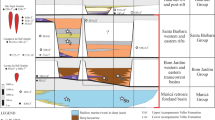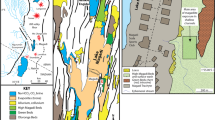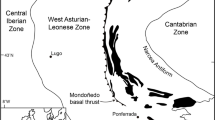Abstract
THE marine sediments on Seymour Island, north-eastern Antarctica Peninsula, have produced numerous plant, invertebrate, and vertebrate remains over the past 80 yr (ref. 1). These strata have been regarded as Campanian (late Cretaceous) and Miocene. Dinoflagellate assemblages, reported here for the first time, indicate that some of the Cretaceous beds may be older (Senonian) than previously suspected and that the supposed Miocene beds are instead late Eocene and early Oligocene in age. These Eocene–Oligocene strata are the only known marine sediments of that age exposed on the Antarctic Continent.
This is a preview of subscription content, access via your institution
Access options
Subscribe to this journal
Receive 51 print issues and online access
$199.00 per year
only $3.90 per issue
Buy this article
- Purchase on Springer Link
- Instant access to full article PDF
Prices may be subject to local taxes which are calculated during checkout
Similar content being viewed by others
References
Harrington, H. J. in Mieghem, J. van & Oye, P. van, Biogeography and Ecology in Antarctica (The Hague, W. Junk, 1965).
Elliot, D. H. et al. Antarctic J. 10, 182–186 (1975).
Howorth, M. K. Falkland Isl. Depend. Survey, Sci. Rep. no. 21 (1958).
Marples, B. J. ibid., no. 5 (1953).
Adie, R. J. in Adie, R. J. Antarctic Geology, 307–313 (North-Holland, Amsterdam, 1964).
Trautman, T. A. thesis, Ohio State Univ. (1976).
Archangelsky, S. Ameghiniana 5, 406–416 (1968).
Archangelsky, S. ibid. 6, 181–218 (1969).
Kemp, E. M. in Hayes, D. E., Frakes, L. A. et al. Init. Rep. Deep Sea Drilling Project, 28, 599–623 (US Government Printing Office, Washington DC, 1975).
Cranwell, L. M. et al. Nature 186, 700–702 (1960).
Cranwell, L. M. Grana Palynol. 5, 397–405 (1964).
Mclntyre, D. J. & Wilson, G. J. N. Z. J. Bot. 4, 315–321 (1966).
Wilson, G. J. ibid. 5, 57–83 (1967).
Wilson, G. J. N. Z. J. Mar. Freshwater Res. 2, 381–389 (1968).
Simpson, G. G. Proc. R. Soc. B 178, 357–387 (1971).
Cranwell, L. M. Nature 184, 1782–1785 (1959).
Cranwell, L. M. Antarctic J. 4, 197–198 (1969).
Verdier, J. P. Cahiers de Micropaléontologie, Sér. 2, no. 4 (1970).
Spath, L. F. Falkland Isl. Depend. Survey, Sci. Rep., no. 3 (1953).
Shackleton, N. J. & Kennett, J. P. in Kennett, J. P., Houtz, R. E. et al. Init. Rep. Deep Sea Drilling Project 29, 743–755 (US Government Printing Office, Washington DC, 1975).
Kemp, E. M. & Barrett, P. J. Nature 258, 507–508 (1975).
Author information
Authors and Affiliations
Rights and permissions
About this article
Cite this article
HALL, S. Cretaceous and Tertiary dinoflagellates from Seymour Island, Antarctica. Nature 267, 239–241 (1977). https://doi.org/10.1038/267239a0
Received:
Accepted:
Issue Date:
DOI: https://doi.org/10.1038/267239a0
This article is cited by
-
Biostratigraphy of Seymour Island, Antarctica (reply)
Nature (1978)
Comments
By submitting a comment you agree to abide by our Terms and Community Guidelines. If you find something abusive or that does not comply with our terms or guidelines please flag it as inappropriate.



